When we think of low-growing hedges, we're most likely to think of boxwood (box) hedging,
Buxus spp, used in knot gardens and to edge herb gardens and herbaceous borders. But today there are other kinds of low hedges — such as "step over" hedges. Step-over hedges are low hedges, usually under 2 feet, created by restricting the growth of larger shrubs through pruning.
This trend can be seen in new British housing estates, where the use of step-over hedges creates a softer visual barrier between properties while blending in with multiple landscape schemes. These low hedges can mark the boundary of your property without losing much space or reducing light the way traditional hedging can. This low hedging can also be used as a feature within other plantings or as a feature against walls or fencing. It can give a sculptural feel better than the tall, naturalistic hedging we are used to.
Many shrubs are suitable, but for optimum step-over hedging, they should be:
- Evergreen
- Slow growing and tolerant of trimming
- Happy to be planted close to other shrubs
- Disease resistant
I think you can see in the following examples just how attractive and effective these hedges can be.
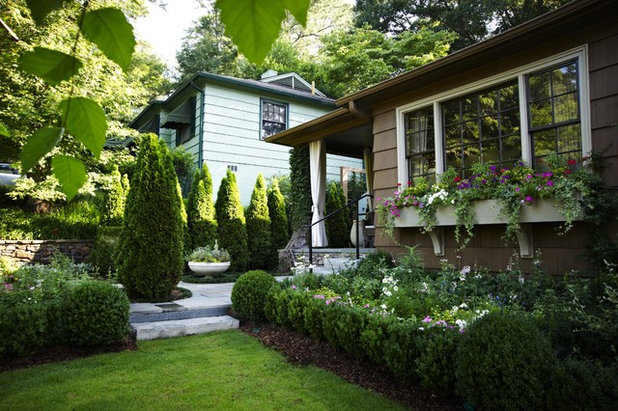
Troy Rhone Garden Design
Boxwood or Box(
Buxus spp)
Boxwood hedging has always been the traditional plant used in dwarf hedging, and though it has its drawbacks, it is still the best general-purpose plant for this type of hedging.
Boxwood can be prone to the fungal disease
Cylindrocladium buxicola, or box blight. This is prevalent in the U.K. and spreading in the U.S.
USDA zones: 5 to 9 (find your zone)
Water requirement: Drought resistant; requires well-drained soil
Light requirement: Prefers partial or full shade; can be scorched by sun
Mature size: 18 to 36 inches tall
Planting tips: Plant in well-drained soil. Boxwood benefits from an application of fertilizer and a mulch after clipping in spring.
Good alternatives to box are
Japanese holly (Ilex crenata) and
box honeysuckle (Lonicera nitida).
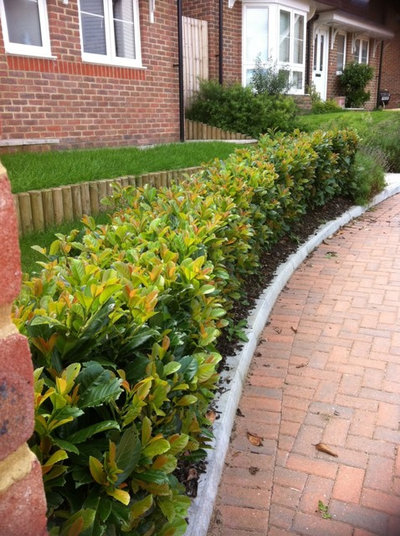 English Laurel(Prunus laurocerasus)
English Laurel(Prunus laurocerasus)Common laurel is another tamable low hedging plant. It's an evergreen shrub that can easily grow to 20 feet tall and wide. But here you can see how it has been controlled by judicious clipping and has formed a superb low formal hedge.
USDA zones: 6 to 9
Water requirement: Drought resistant
Light requirement: Sun or partial shade
Mature size: 25 to 30 feet tall
Planting tips: Requires feeding in poorer soils, where the leaves can become chlorotic
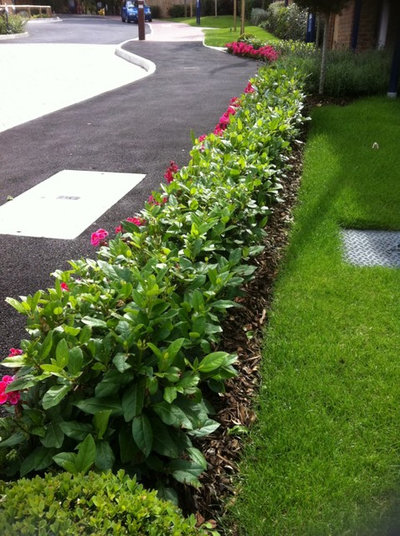 Laurustinus
Laurustinus(
Viburnum tinus 'Eve Price')
Laurustinus is another large, bushy evergreen that you would not believe could be controlled enough to create a step-over hedge
Here the variety 'Eve Price' creates a stunning dwarf hedge, as it is more compact than some of the other varieties of
Viburnum tinus. The flowers, blooming in late autumn to early spring, are very attractive, with carmine buds and pink-tinged petals.
The hedge shown here is cleverly underplanted with bright pink geraniums, which contrast beautifully against the lush summer foliage of the Viburnum.
USDA zones: 7 to 10
Water requirement: Drought resistant
Light requirement: Full sun to full shade
Mature size: 8 to 10 feet tall
Planting tips: Grows well in moderately fertile and humus-rich soil, but soil must be well drained
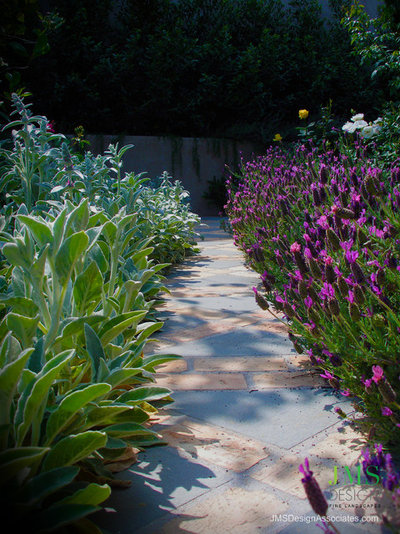
JMSDesignAssociates
Lavender(Lavandula stoechas)Spanish lavender, also known as French lavender in the United Kindgom, has unusual blackish-purple flowers surmounted by a tuft of purple bracts.
For dry, sunny spots, lavender can make a good low hedge. Though it can be short lived, it is still the best of the low-growing aromatic shrubs.
USDA zones: 6 to 9
Water requirement: Low; benefits from additional watering
Light requirement: Full sun
Mature size: 18 to 36 inches tall
Planting tips: Prefers well-drained soil in full sun; if grown in containers, it will require frost protection.
A good alternative to lavender is rosemary — which also loves a hot, sunny spot. Perhaps the best variety to use for low hedging is the compact
Rosmarinus officinalis 'Severn Sea', which has evergreen leaves and brilliant blue flowers in early summer.
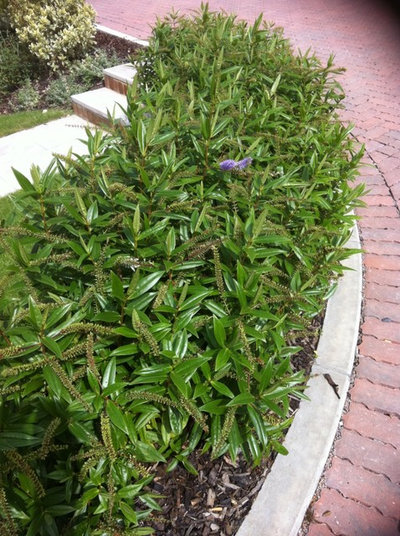 Hebe(Hebe
Hebe(Hebe x
andersonii)Hebes, primarily from New Zealand originally, differ widely in height, leaf size and flower color. Some of the lower-growing varieties make super step-over hedges.
I was always taught, "The smaller the leaf on Hebes, the hardier the variety." While I'm not sure if that is true, it has always worked for me.
Hebe x
andersonii is a vigorous grower, but with careful pruning it makes a low hedge that provides a summer of soft lavender-blue flowers fading to white in fall.
USDA zones: 9 to 10
Water requirement: Moderate
Light requirement: Full sun or partial shade
Mature size: 6 to 8 feet tall
Planting tips: Grows best in moist but well-drained soil.
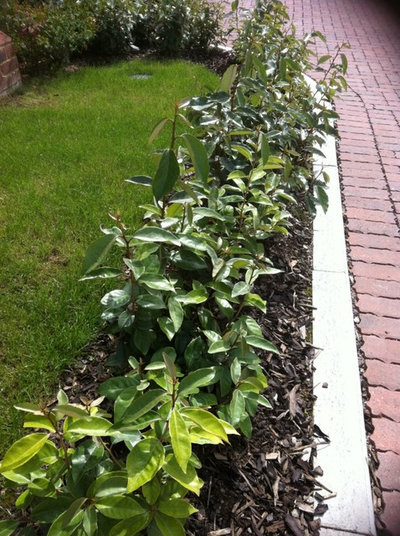 Elaeagnus(Elaeagnus
Elaeagnus(Elaeagnus x
ebbingei)Elaeagnus x
ebbingei has wonderful dark green leaves with silvery-pewter undersides and small fragrant flowers.
Even some of the more open-growing shrubs can be formed into attractive low evergreen barriers. Evergreens like Elaeagnus should be pruned in spring just before growth starts.
USDA zones: 7 to 11
Water requirement: Drought resistant
Light requirement: Full sun or partial shade
Mature size: 9 to 12 feet tall
Planting tips: Grow in well-drained soil; good for exposed and coastal situations
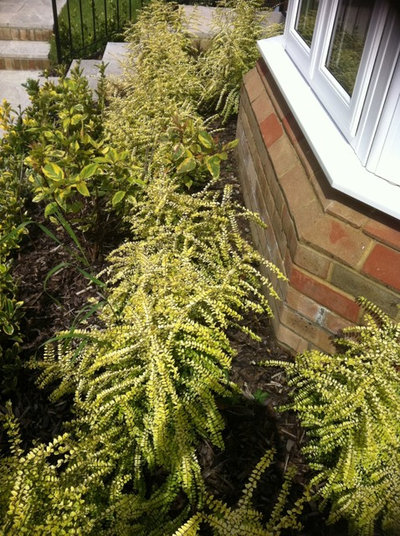 Box Honeysuckle
Box Honeysuckle(
Lonicera nitida 'Baggesen's Gold')
Box honeysuckle is a small-leaf evergreen that is perfect for clipping. It is great for hedging, as it is quick to regrow — though it will reach a height of 7 to 8 feet if not contained.
Lonicera nitida 'Baggesen's Gold', shown here, has the added advantage of bright yellow foliage in summer that turns a yellow-green in autumn.
USDA zones: 6 to 9
Water requirement: Drought resistant
Light requirement: Full sun to partial shade
Mature size: 7 to 8 feet tall
Planting tips: Prefers well-drained soil. Its bright yellowish foliage can become greenish-yellow in shade.
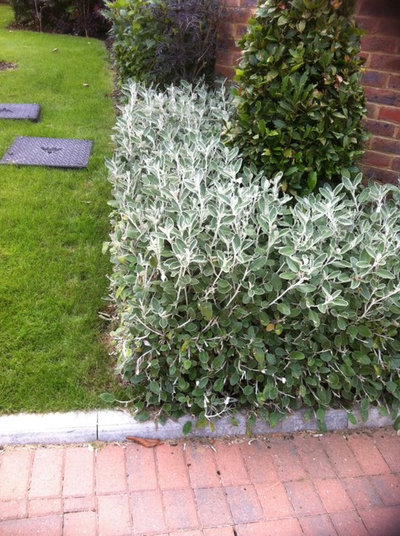 Daisy Bush(Brachyglottis greyi)
Daisy Bush(Brachyglottis greyi)For a beautiful gray hedge that is pretty hardy, it is hard to beat
Brachyglottis greyi. The plant is sometimes sold as
Senecio greyi or
Senecio 'Sunshine'
.One thing that you will most likely miss with judicious pruning is the bright yellow daisy-like flowers that cover the plant in summer. This hedge will need to be pruned at least twice a year to keep it in shape.
USDA zones: 8 to 10
Water requirement: Low
Light requirement: Full sun or partial shade
Mature size: 3 to 5 feet tall
Planting tips: Grow it in well-drained soil, preferably in full sun.
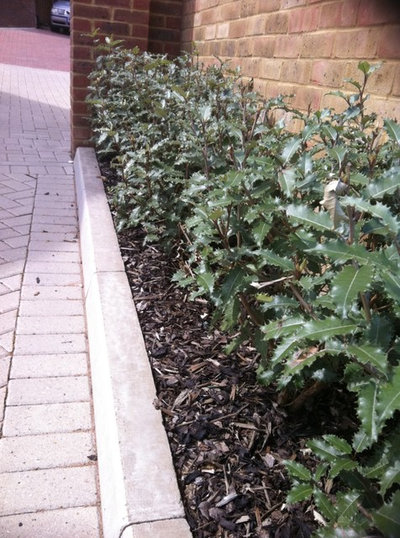 Mountain Holly(Olearia ilicifolia)
Mountain Holly(Olearia ilicifolia)Mountain holly is another large evergreen shrub from New Zealand. It can reach 6 feet in height, but once again, with timely pruning in spring it can be restricted to become a step-over hedge.
The gray-green leaves are narrow and spear shaped, with undulating and toothed edges that make it perfect for deterring dogs from entering your garden. If unpruned it will flower in spring with fragrant white blooms.
USDA zones: 8 to 10
Water requirement: Minimal, especially in winter months
Light requirement: Full sun
Mature size: 6 feet tall
Planting tips: Grow it in a fertile, well-drained soil in full sun and shelter it from cold winds.





